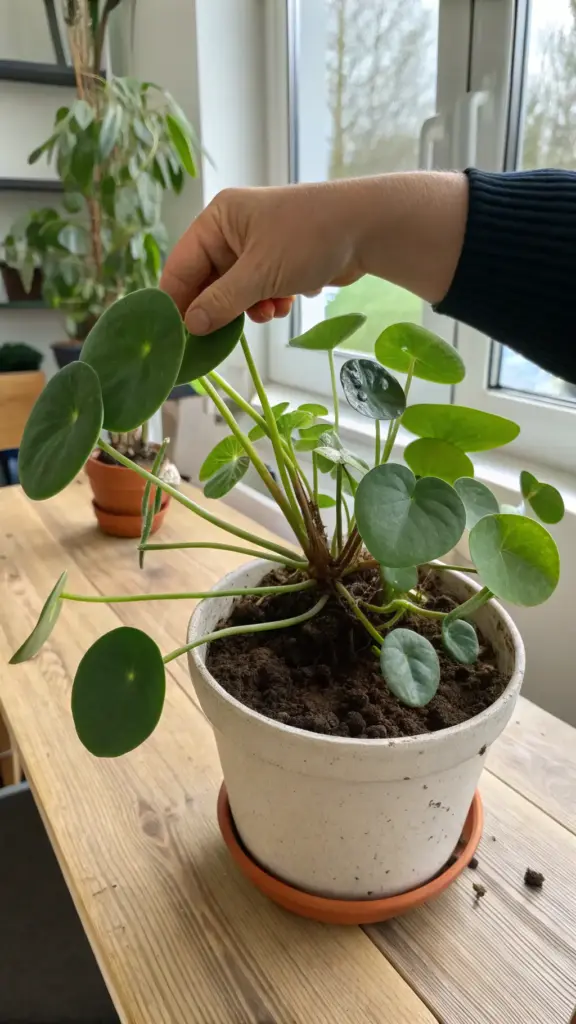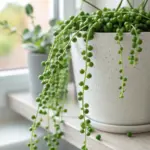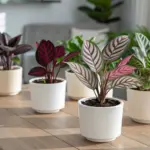2. They Follow a Strategic Watering Schedule

Okay, let me tell you about my biggest plant parent fail ever. I used to water my Chinese money plant every Sunday like clockwork, thinking I was being so responsible.
That poor plant probably thought I was trying to drown it on purpose! Turns out, consistent watering schedules are actually terrible for Pileas.
The pros don’t water by calendar dates – they water by what the plant actually needs. Mind blown, right?
The Professional “Finger Test” Method
Every nursery owner I’ve talked to does this same thing, and now I’m obsessed with it. Stick your finger about 2 inches deep into the soil near the edge of the pot.
If it feels dry at that depth, it’s watering time. If there’s any moisture at all, wait another day or two.
This simple test has saved more of my plants than any fancy moisture meter. I check my Pilea every 3-4 days, but I only water when that finger test says go.
The top inch of soil can be bone dry, but if there’s still moisture underneath, you’ll cause root rot by watering too soon.
Why Bottom Watering Changed Everything
I used to pour water right on top of the soil like most people do. Then a nursery owner showed me bottom watering and I felt like such an amateur.
Here’s how it works: Put your pot in a shallow dish of water and let the plant drink from the bottom up. Takes about 15-20 minutes for the soil to get properly moist.
Bottom watering prevents water from sitting on the leaves and causing those ugly brown spots I used to get all the time. Plus, it encourages roots to grow deeper and stronger.
I use a old pie tin that’s perfect for my 6-inch pots. The plant takes exactly what it needs and stops – no more guessing games!
Seasonal Watering Adjustments That Work
This was another lightbulb moment for me. Winter watering needs to be completely different from summer watering.
During growing season (spring and summer), my Pilea drinks water every 5-7 days. But in winter? Sometimes it goes 10-14 days between waterings.
The plant basically goes into hibernation mode and using way less water. I learned this after killing a plant by maintaining my summer watering schedule through December.
Fall is tricky because the plant is transitioning. I start spacing out waterings gradually as the days get shorter.
Spotting Overwatering vs. Underwatering Signs
Overwatering symptoms I’ve seen way too many times:
- Yellow leaves that feel mushy
- Black or brown roots (yikes!)
- Soil that smells funky
- Leaves dropping from the bottom up
Underwatering looks totally different:
- Leaves get crispy and curl inward
- The whole plant looks droopy and sad
- Soil pulls away from the pot edges
- New growth stops completely
Overwatering kills way more Chinese money plants than underwatering. When in doubt, wait another day before watering.
Water Quality Makes a Huge Difference
I used to just grab water straight from the tap, but chlorinated water was stressing my plants without me realizing it.
Now I fill up a pitcher and let it sit overnight before watering. The chlorine evaporates and my plants are noticeably happier.
Filtered water is even better if you’ve got it. I noticed my Pilea’s leaves got glossier and more vibrant after switching to filtered water.
Room temperature water is crucial too – cold water shocks the roots and can slow growth for weeks.
Want to know the lighting secret that makes Chinese money plants produce those adorable baby plantlets faster? Hit that “next” button to discover the light positioning tricks that nursery pros use to maximize growth!









GIPHY App Key not set. Please check settings